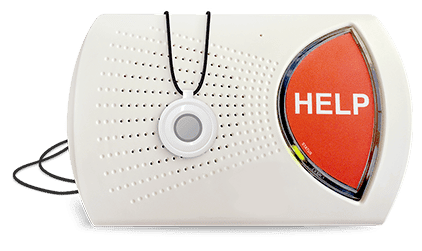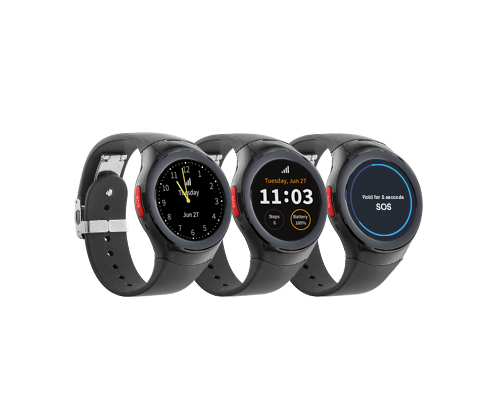MedicalAlertBuyersGuide.org is an independent review site. We may earn compensation from the providers below. Learn More
Here we’ve compiled some of the most commonly asked questions that we encounter about wearable medical alert systems, whether home systems, mobile systems or smartwatch systems.
General Information on Medical Alert Systems

What does a medical alert system cost?
A medical alert system can cost from as little as $19.95 per month up to twice that amount or even higher. Typically, optional features such as fall detection can cost an extra $10 per month. Our comparison reviews of the best brands will show you much of this information at a glance. You can buy just the equipment itself with no monthly charges, but this means there’s no 24/7 monitoring, which frequently defeats the purpose – see our article on No Monthly Fee vs Monitored Systems.
What should I look for in a medical alert system?
Make sure you understand all the charges and fees, including initial equipment cost and the length of contract (we recommend monthly contracts only, not longer term contracts). Know the refund and return policy. Make sure the type of system meets your purpose, whether for in-home protection, mobile portability or both – include all the features you will want, such as fall detection or GPS tracking. Make sure the person who will use the system is comfortable and committed to actually wearing it. Make sure you can transfer your base location easily in case of evacuation, vacation, etc. Our comparison reviews will always include: battery life, fall-detection reliability, monitoring center response time, and total cost.
Will Medicare pay for my medical alert system?
The short answer is that basic Medicare does not cover medical alerts, but Medicare Advantage and some private insurances may cover them, depending on your plan. Read our article on Does Medicare Pay For a Medical Alert Device for more detailed information.
Can I get Discounts?
Many of the companies we review offer discounts for seniors and special offers, including for AARP members. Check our overview of Discounts For AARP Members.
What types of alert systems are there?
The three main types of medical alert system are home-based, mobile, and now smartwatch. The pendant style, worn around the neck or clipped on a belt or purse, is the original style of wearable system, both for home and outdoor use, and this has now been supplemented by the advent of the smartwatch, worn on the wrist – see below for more details on smartwatches.
How does a medical alert system work?
A person wearing the alert system can press a button in an emergency and send a signal to alert contacts or to reach a 24/7 monitoring center, with 2-way voice connection to speak to the contact or an operator. With fall detection installed, this emergency call may be made automatically – usually with safeguards to confirm or cancel in the event of a false trigger of the alarm.
Does it work with my phone?
Most systems are designed to work with most of the phone services, using an existing landline service if one is present, integrating with cable providers and VOIP services, or connecting directly to the cellular network – the mobile versions use the cell network exclusively of course. Your coverage is important to confirm before you choose, especially if you live in a rural area. Note that the base station will stay connected with your home device if you’re outdoors, for a variable distance that could be as far as 1,000 feet away – check this range before you buy if you expect outdoor usage (not to be confused with mobile travel of farther distances).
How easy is a system to set up?
Most systems will have a base station and a wearable device, and the base station will have a battery backup in case of a power outage – the wearable device is exclusively battery operated. Typically the setup has been made as simple as possible, with voice prompts to tell you when the system is connected, and a test voice contact with the monitoring center. Custom installation for a fee is often available as well. Our reviews test for ease of setup and ease of accessing support.
How long does the battery last?
The battery in the wearable device can last from 24 hours up to about four days. Learn the battery life before you buy, and see our guide to Mobile Device Battery Life for more. (Note that a smartwatch that’s paired with a smartphone will require charging both devices adequately to function.)
Is the wearable device waterproof?
Many devices are made waterproof, while others are only water resistant. They are all usually resistant enough to wear in the shower – a prime place for accidents. It’s important to find out how waterproof your device is before using it in water- some devices cannot be immersed fully.
Can more than one person be protected at a location?
Some brands will offer free spouse coverage, charging for an extra device but using the same base station. Some brands will charge separately for additional persons – establish this before you buy.
What are the Smartwatch options?

There are two kinds of medical alert smartwatches: the standalone alert device that connects remotely on its own and is exclusively designed as a wearable medical alert system, and the smartwatch that is paired with a smart phone. This second type is an accessory to its parent phone, and includes medical alert features as well as the phone features. There are large differences between the two, notably in cost, battery requirements, pairing, dedicated monitoring and complexity of use. See our comparison guide and testing review of the Best Medical Alert Smartwatch.
How much does a smartwatch cost?
The equipment cost can range from around $150 up to $500 and above, with monthly services adding to this cost. At Medical Alert Buyer’s Guide, we don’t sell smartwatches (or any devices) ourselves, we purely test, review and recommend them. Our pick for “Best Medical Alert Smartwatch” currently is the SOS Smartwatch from Bay Alarm Medical. See it here.
What features do smartwatches have?
Dedicated medical alert smartwatches can include fall detection, 2-way voice connection, 24/7 monitoring center, GPS location tracking, useful apps such as for weather, and health and fitness features such as step-counting. They have their own SIM card and connect to the cell network without the wearer even needing to own a cell phone.
Do smartwatches work with all phone types?
Medical alert smartwatches don’t need a phone at all. They come with a built-in cellular capability and you pay for that as part of your monthly subscription. That’s one big advantage they have over the Apple Watch, which needs an iPhone to work, and other such phone-paired watches.
